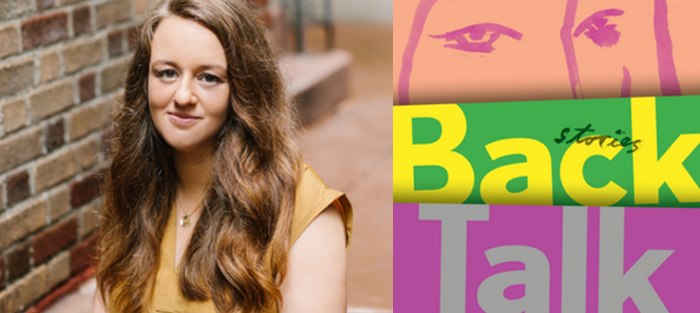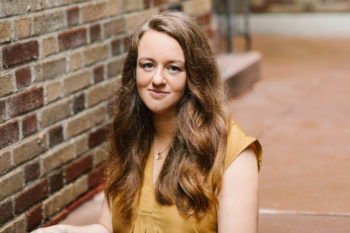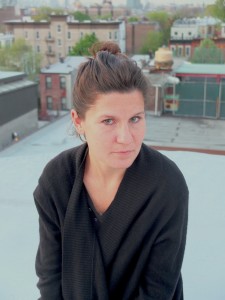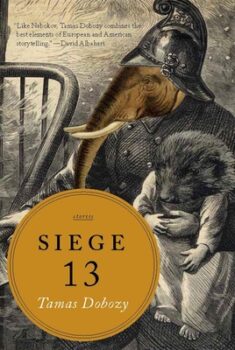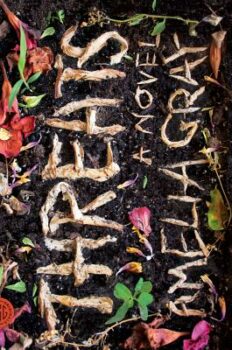Danielle Lazarin’s stories build like an uptown A train, first shaking the dirty puddles at your feet, then lifting your hair, then barreling into your guts like you never saw them coming. Her debut collection, Back Talk (Penguin Books), is a tight circle of sixteen stories that speak to each other like old friends—warm, irreverent, and brutally honest. They show women in all their complex, messy, fighting glory—the tone is both intimate and expansive. Through the lens of her characters, women and girls navigating a world made without them in mind, Lazarin allows her readers to reckon with the ways we overlook each other.
I first met Danielle six years ago, spotting her across the Heckscher Playground at Central Park, waving me over like she owned the place. And she did, in a way. Lazarin grew up in New York, which features heavily in the stories, and is a woman comfortable in her city and her skin—an outing with her makes you want to be a more badass version of yourself.
Her stories have appeared in Glimmer Train, Michigan Quarterly Review, Indiana Review, Colorado Review, Copper Nickel, Boston Review, The Southern Review, and elsewhere. She’s working on a novel.
We texted over two days in early January, between writing and school pickup, the dregs of a bomb cyclone, and some rain that finally quashed the fires in L.A. It’s the end times, people, get your hands on this book.
The interview has been lightly edited for clarity and length.
Interview:
Lee Thomas: Oprah delivered a speech at the Golden Globes last night. Did you watch it yet?
Danielle Lazarin: Stayed up to watch it.
Yes, you did.
AMAZING.
One of the things she said was, “What I know for sure is that speaking your truth is the most powerful tool we all have.” Let’s start there. I feel like Back Talk is kind of an answer to this, a decade or more in the making. Do you think that the voices of women are about to crash over the land like a wave?
That line really spoke to me, too.
I think we have always had boundary-breaking stories from women because unfortunately there are still so many boundaries to break, stories to share. I know that I have been grateful for every one I’ve stumbled upon, and that they’ve given me fire to write mine. I hope what we are seeing now is more boldness both from women writers to tell our stories as honestly as we can, and on the part of gatekeepers to widen the kinds of narratives we expect women writers to tell.
 Your opening sentence has three women—one dead—and zero sentimentality. It’s … refreshing.
Your opening sentence has three women—one dead—and zero sentimentality. It’s … refreshing.
I’m not a sentimental or nostalgic person, and that definitely seeps into my work. I find that many women are like this in private: honest, cutting, daring to say to one another what they won’t say in a more public space—not even necessarily because they need to say something risky, but because so often women’s boundaries are violated in public spaces, and private ones are better rooms for more probing conversation—and those stories that we trade with one another are where my interest lies. I’m interested in the stories we tell outside the male or public gaze, when we are just bitching about our lives or trying to work through problems by talking it out with a friend.
Do you think readers come to “women’s fiction” with certain expectations?
I think the expectation for women’s fiction and for women’s narratives in general is that they all end in a similar place, as if we share a monolithic experience of womanhood. Not only does it end with marriage and babies but in a blissed out gratitude for all that, or perhaps mournfulness when that doesn’t happen. My characters are normative in so many ways, and many are in marriages or do have children, but I hope that their conflicts and choices reflect a more nuanced portrait of what it means to be a woman.
Do you think those people have really read books by women widely?
Who do you mean by “those people”?
I think I mean people dismissive of books by women.
I think very few of us read books by women widely by default—it’s just not how school curriculums, and till fairly recently, book buzz machines, worked. I’ve long considered myself a feminist, but it wasn’t till a number of years ago that I began to be more conscious of the sorts of books that made their way onto my radar. What I’ve found is that there is always a book by a woman I want to read over a book by a man. Maybe it’s years of course-correction, but I am hungry for more stories about women. There won’t ever be enough. I think all of us could use that course correction.
There’s that glorious sense of diving below the surface that all great literature does. The reader sees the outside markers of your characters and then jumps into the water and it’s all murky and mysterious. One of the best examples of this was “Hide and Seek,” where the woman in the story is to some extent protecting her younger brother as he thinks he’s protecting her. You’re really good at juggling multiple layers of secrets. How do you think that secrets operate in families?
I think layers are exactly it, and as you point out, protective layers. They are not malicious secrets, not even for a woman who is cheating on her husband, or for a child who has seen what she knows her father wouldn’t want her to see. Most of the characters in families in my stories keep things from one another in order to spare them something they think they can’t handle; Margaret in “Looking for A Thief” hides something from her husband for a similar reason. In families, there’s a sense of knowing it all—as in, most everyone in a family thinks they can see the whole of it, all of its parts, and that they alone are working in its best interest—but for my characters, once these secrets come to light, that’s where the wound happens. It’s not around the secret itself, but around the keeping it, the kind of vulnerability family members project onto one another that maybe makes them feel seen in the worst light, and that hurts, the idea that they can’t handle what exists in the space between them, in their own family.
There’s also that willful ignorance at play, the desire NOT to see. Like in “Appetite,” where Claudia realizes her father’s view of her is “a secret he’s not interested in discovering.”
Yeah, so I guess that’s true, too, for some characters. Sometimes they are correct in what the others shouldn’t know. So much of that story is Claudia gauging her father’s limits with her and her sister. That’s a big part of coming-of-age stories, to my mind, one that isn’t portrayed a lot: how when we grow up, we start to understand the adults around us, and specifically our parents, as limited, flawed people. How humbling and disappointing and relieving it can be to understand that.
That’s so apparent in the stories with younger women. On the flip side, how do you think your grown-ass women characters use secrets? There’s that line in “Landscape No. 27”: “In those days, I needed a secret.” Also, a mother who hides a tent in her trunk, you know, JUST IN CASE. I laughed when I read that detail, it was so true and so funny and heartbreaking.
JUST IN CASE, indeed. I think for the older women in the stories, secrets are a way to reclaim a space that belongs just to them. When writing and editing these stories, I thought so much about the question of what is selfish behavior—or in this case, even thoughts—about where that bar is for women. And both of these women are mothers, and wow, that bar is pretty low if you wade in there. We live in a time where the start of every story a mother tells about her children not being perfect is supposed to be, “I love my children, but…” and the ending something like, “…but I wouldn’t trade it for the world!” Yet there are plenty of mothers who consider trading these “blessings”—the stable marriage, the averagely challenging child, the financial privilege of being a primary caregiver. These stories, about the secret ways women look for and think about and act upon “outs,” that all these choices are actually not enough to feel full in life, shouldn’t be buried.
NEW YORK. You have a great line about the city: “Whistles and thumps and everything in contact with everything else.” That’s kind of New York in a nutshell. Can we talk a little about New York? Your New York—you grew up there. You’re very much of the place—as is Back Talk.
Let’s talk about this dirty, vibrant city, yes.
It’s funny, because I’m living in Manhattan, which is what most of the rest of the country thinks about as “New York,” for the first time in my life. I see that, but I grew up in Riverdale, which is in the Bronx, in a house with a yard, which informs a lot of the stories about childhood in the collection. And the neighborhood I live in now is also quiet and similar and kind of small town. My New York is this, and I wanted it to be in the stories.
There is also a glitzier New York—the families in “Spider Legs” and “Second Chance Family,” which take place twenty years apart, clearly are more centered in that kind of moneyed and worldly fast-paced New York. The thing about growing up here is that it does overlap, that “everything in contact with everything else,” and that’s what makes it all so frustrating and insane. There is so much you can see and sometimes even touch but not have in New York (as well as so much you can be willfully ignorant to), and yet that kind of wanting becomes a normal part of living here, of knowing what is not for you, of knowing that there are so many other lives that will not be yours. Maybe my New York is not the city of big dreams but the one of mundane resignation? I want to show New York as if it is any other place, just with, like, millions more people and much more walkable.
The New York stories are also colored by the independence a city affords teenage girls. Moving around without parents gives you a certain freedom but for girls, also a quick understanding of how you’re perceived in the world—as closer to a woman, often sexualized before you’re ready to be. The city shapes the awareness of a lot of my younger characters in that way.
Your stories deal with that class-consciousness in a way I hadn’t seen in fiction before. It’s kind of a hum in the background, but rarely rises to a foreground issue. The teenage girls without train fare home walking past the guy in a Brioni suit in Central Park. Do you think that kind of mash-up breeds more tolerance of fate or resentment? Or both?
It’s hard to say, because it’s so ingrained in my upbringing, to accept that all of this is simultaneously happening in this city, and in so many other places. I think it breeds both, and a kind of reaching that some of the characters have for themselves, or their parents do for them: the idea that NYC has all these options, private schools, and things you can pay for—camps, bigger apartments, fancy parties, lessons, whatever— that will change who you are perceived to be in the world. But all of the real-estate owning characters in my book certainly aren’t the happiest, and what they want is more often security in their connections to others than to own a piece of New York in some way. But put another way, I do think that most of my New York characters have a strong sense of how much power their socio-economic status gives them. Though they don’t always care to use it, that sort of presence of a different life as possible, always, is a very New York aspect of the book.
“The way the women are together is its own foreign country…” So jealous of that line. Can you talk about the generations looking up and down? Many of the close sisterhoods between younger characters end up being broken in some way. But it’s not as simple as “older women have friendships that last.” Is there a kind of rediscovery of female friendship that happens after adolescence?
You know, I’ve never noticed that pattern in the book, but you’re right. There are a lot of stable friendships between the older women in the book, especially as pairs of younger women—Franny and Lucia in “Weighed and Measured,” and Nicole and Mirabelle in “Gone”—are disintegrating; they’re looking at the ease between older women, who appear to be together more effortlessly. With younger girls, friendships are everything, the first real bonds we make outside of the family unit. They’re the first choices we make in love, how we learn to show love to people who don’t assume they already have it, and tests of what we will take in relationships. Our adolescent friendships are such great teachers. They were certainly my first heartbreaks, more so than boys. Adult friendships arise from different needs: commiseration in a career or parenthood or a city that isn’t home. Robin and Juliet in “Floorplans” have this brief and intense friendship that is very intimate but is also hinged on the fact that they’re choosing to help one another through a strange moment in their lives, and that the moment will end for them both. They both seem okay with that, with that immediate need and the understanding that it will end.
Maybe it’s that deeper understanding of needs, and having them more clearly defined that sets apart the friendships between older women. Girls have so much time, lazy days with nowhere to be, that they can build a kind of intense friendship in weeks or months that might take years for older women to develop.
Yes! Our worlds are much narrower in our youth, and obsession comes more easily. And you’ve just made me understand how I was grasping for capturing those unfilled days so many teenagers in this book seem to have. Maybe I am nostalgic after all.
Let’s talk about anger. Women have traditionally been punished, censured, silenced for showing anger. But you have a lot of angry characters—with cause. “I was annoyed by the collective failure of your imaginations, by your inability to follow me into the hard place I was going …” says the narrator in “Landscape No. 27.” And there’s that Lynn Steger Strong piece on women’s anger where she says, “Maybe it’s internal, this anger. Maybe we are angry at ourselves. At one another. Maybe we’re mad that we just took it. Maybe our fury has to do with how we are not all monstrous enough to burn the actual monsters down.” Your title story, wow, the anger a reader feels on that fifteen-year-old’s behalf. How do you think about anger in relation to your characters? Does it fuel them? Blind them? Clarify their situations?
Yes, let’s talk about anger. I loved Strong’s essay so much. I would say I wrote and revised many of these stories with the sort of anger she describes, that low-level fury that exists in part because we are told as women that our fury isn’t worthy of being a story, that we shouldn’t ask for more, that we should be happy to have what we’ve been given as women, any voice at all, any space.
Like Strong, I found that the place where my anger wasn’t dismissed, where it barely needed to be expounded it was so immediately understood, was with other women. I think my characters are not unlike me in this way, in that a lot of them are just beginning to tap into that anger, to see the gulf between what they know they deserve or want and what the world will yield to them. Though I’d also say that I was much closer to my anger in my teen years and early twenties, and writing these stories helped me remember that and find my way back to that fruitful anger.
But there’s a reason my stories have been called quiet, and I think that women’s stories are generally: my characters, like many women, take this anger in, this comprehension, or sharpening of the spaces they’re in, but they don’t often direct it outwards. Women in my stories, like so many women I know, are well practiced at accepting the state of things and carrying on. It took me writing these stories to understand that I’d been carrying rage with me, and what I’d done to suppress it even as I didn’t believe in suppressing it. I have had many conversations with friends about the particular nerve that Kristen Roupenian’s “Cat Person” touched, that recognition of something kind of banal and yet so horrible that we’d allow to be commonplace for ourselves yet to watch it in others is like watching our friends go through it and being like NUH-UH! Nope! Sometimes it’s the reader who has the reaction instead of the character.
Rebecca Solnit wrote in her recent essay “Let this Flood of Women’s Stories Never Cease”: “But ignorance is one form of tolerance, whether it’s pretending we’re in a colorblind society or one in which misogyny is some quaint old thing we’ve gotten over. It’s not doing the work to know how the people around you live, or die, and why.” Back Talk is most certainly doing the work. The stories are such a pleasure, a revelation of women—for me there is the shock of recognition, story after story. What art is doing the work for you right now?
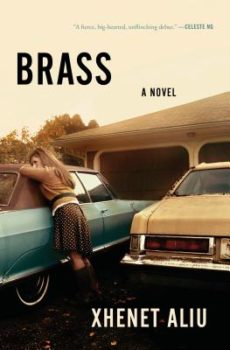 There’s a set of books I think about that unlocked doors for me in writing Back Talk for how they boldly approached women’s stories: Elisa Albert’s After Birth, Jaime Quatro’s I Want to Show You More, Elena Ferrante’s Days of Abandonment, Lidia Yuknavitch’s The Small Backs of Children, and so many more over the decades before. More recently, I’ve been floored by Xhenet Aliu’s Brass and Kayla Rae Whitaker’s The Animators, both debut novels that had me laughing and crying and deeply immersed in female characters that show as much fierceness as they do vulnerability. This summer, I read Jamaica Kincaid’s Lucy, a book that tore through me for its narrator’s unsparing point of view on family, feminine expectations, and what it means to be free of both of those. I listen to a lot of music, not while I work, but while I walk or ride the subway, and I’ve found myself returning to lots of women I listened to in my younger years, who have been unafraid of their own anger: Fiona Apple, Ani DiFranco, Liz Phair, Tegan and Sara. I spent a lot of last fall listening to the Lorde album, which also made me feel like my fiercest nineteen-year-old self.
There’s a set of books I think about that unlocked doors for me in writing Back Talk for how they boldly approached women’s stories: Elisa Albert’s After Birth, Jaime Quatro’s I Want to Show You More, Elena Ferrante’s Days of Abandonment, Lidia Yuknavitch’s The Small Backs of Children, and so many more over the decades before. More recently, I’ve been floored by Xhenet Aliu’s Brass and Kayla Rae Whitaker’s The Animators, both debut novels that had me laughing and crying and deeply immersed in female characters that show as much fierceness as they do vulnerability. This summer, I read Jamaica Kincaid’s Lucy, a book that tore through me for its narrator’s unsparing point of view on family, feminine expectations, and what it means to be free of both of those. I listen to a lot of music, not while I work, but while I walk or ride the subway, and I’ve found myself returning to lots of women I listened to in my younger years, who have been unafraid of their own anger: Fiona Apple, Ani DiFranco, Liz Phair, Tegan and Sara. I spent a lot of last fall listening to the Lorde album, which also made me feel like my fiercest nineteen-year-old self.
Bet you rue the day you kissed a writer in the dark.
It’s all a story, isn’t it? I love that line for how it admits this, how so many of us will take the things that make us feel and then use them for art. I think way less autobiographically than most people assume, but we will no doubt take a moment we’ve had—a kiss, a break in trust, a spot of happiness—and try to recapture that feeling for our work.

